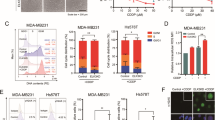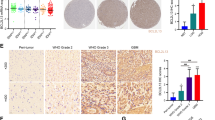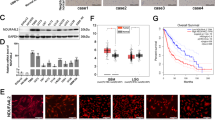Abstract
Gain of chromosome 17q correlates with high-stage disease, an adverse clinical outcome and leads to the overexpression of the antiapoptotic protein BIRC5/Survivin in neuroblastoma (NB). We have shown before that Survivin defines a threshold for the sensitivity of NB cells to DNA-damaging chemotherapeutic agents that require FOXO3 activation for apoptosis induction. To investigate the molecular basis of apoptosis inhibition we analyzed the function of Survivin at mitochondria and uncovered that Survivin induces mitochondrial fragmentation, reduces mitochondrial respiration and represses BCL2L11/Bim. Mitochondrial fission depends on Survivin-induced recruitment of the fission regulator DNM1L/Drp1 to mitochondria. In parallel, Survivin expression inhibits the respiratory complex-I, thereby preventing reactive oxygen species accumulation and, as a consequence, FOXO3-induced apoptosis. The loss of energy production via oxidative phosphorylation is compensated by increased glycolysis in Survivin-overexpressing NB tumor cells. Glycolysis inhibitors neutralize the antiapoptotic effect of Survivin and sensitize high-stage NB to DNA-damaging drugs. This suggests that glycolysis inhibitors target an ‘archilles heel’ of Survivin-overexpressing NB and may be highly useful as chemosensitizers in the treatment of high-stage NB.
This is a preview of subscription content, access via your institution
Access options
Subscribe to this journal
Receive 50 print issues and online access
$259.00 per year
only $5.18 per issue
Buy this article
- Purchase on Springer Link
- Instant access to full article PDF
Prices may be subject to local taxes which are calculated during checkout






Similar content being viewed by others
References
Brodeur GM, Seeger RC, Schwab M, Varmus HE, Bishop JM . Amplification of N-myc in untreated human neuroblastomas correlates with advanced disease stage. Science 1984; 224: 1121–1124.
Islam A, Kageyama H, Takada N, Kawamoto T, Takayasu H, Isogai E et al. High expression of survivin, mapped to 17q25, is significantly associated with poor prognostic factors and promotes cell survival in human neuroblastoma. Oncogene 2000; 19: 617–623.
Opel D, Poremba C, Simon T, Debatin KM, Fulda S . Activation of Akt predicts poor outcome in neuroblastoma. Cancer Res 2007; 67: 735–745.
Obexer P, Geiger K, Ambros PF, Meister B, Ausserlechner MJ . FKHRL1-mediated expression of Noxa and Bim induces apoptosis via the mitochondria in neuroblastoma cells. Cell Death Differ 2007; 14: 534–547.
Obexer P, Hagenbuchner J, Unterkircher T, Sachsenmaier N, Seifarth C, Bock G et al. Repression of BIRC5/survivin by FOXO3/FKHRL1 sensitizes human neuroblastoma cells to DNA damage-induced apoptosis. Mol Biol Cell 2009; 20: 2041–2048.
Hagenbuchner J, Kuznetsov A, Hermann M, Hausott B, Obexer P, Ausserlechner MJ . FOXO3-induced reactive oxygen species are regulated by BCL2L11 (Bim) and SESN3. J Cell Sci 2012; 125: 1191–1203.
Karbowski M, Norris KL, Cleland MM, Jeong SY, Youle RJ . Role of Bax and Bak in mitochondrial morphogenesis. Nature 2006; 443: 658–662.
Sheridan C, Delivani P, Cullen SP, Martin SJ . Bax- or Bak-induced mitochondrial fission can be uncoupled from cytochrome C release. Mol Cell 2008; 31: 570–585.
Chen H, Chomyn A, Chan DC . Disruption of fusion results in mitochondrial heterogeneity and dysfunction. J Biol Chem 2005; 280: 26185–26192.
Kudin AP, Bimpong-Buta NY, Vielhaber S, Elger CE, Kunz WS . Characterization of superoxide-producing sites in isolated brain mitochondria. J Biol Chem 2004; 279: 4127–4135.
Giorgio M, Migliaccio E, Orsini F, Paolucci D, Moroni M, Contursi C et al. Electron transfer between cytochrome C and p66Shc generates reactive oxygen species that trigger mitochondrial apoptosis. Cell 2005; 122: 221–233.
Connor KM, Subbaram S, Regan KJ, Nelson KK, Mazurkiewicz JE, Bartholomew PJ et al. Mitochondrial H2O2 regulates the angiogenic phenotype via PTEN oxidation. J Biol Chem 2005; 280: 16916–16924.
Chen K, Albano A, Ho A, Keaney JF . Activation of p53 by oxidative stress involves platelet-derived growth factor-beta receptor-mediated ataxia telangiectasia mutated (ATM) kinase activation. J Biol Chem 2003; 278: 39527–39533.
Vazquez A, Liu J, Zhou Y, Oltvai ZN . Catabolic efficiency of aerobic glycolysis: the Warburg effect revisited. BMC Syst Biol 2010; 4: 58.
Heiden MGV, Cantley LC, Thompson CB . Understanding the Warburg effect: the metabolic requirements of cell proliferation. Science 2009; 324: 1029–1033.
Valko M, Rhodes CJ, Moncol J, Izakovic M, Mazur M . Free radicals, metals and antioxidants in oxidative stress-induced cancer. Chem Biol Interact 2006; 160: 1–40.
Fischer K, Hoffmann P, Voelkl S, Meidenbauer N, Ammer J, Edinger M et al. Inhibitory effect of tumor cell-derived lactic acid on human T cells. Blood 2007; 109: 3812–3819.
Stern R, Shuster S, Neudecker BA, Formby B . Lactate stimulates fibroblast expression of hyaluronan and CD44: the Warburg effect revisited. Exp Cell Res 2002; 276: 24–31.
Simonnet H, Alazard N, Pfeiffer K, Gallou C, Beroud C, Demont J et al. Low mitochondrial respiratory chain content correlates with tumor aggressiveness in renal cell carcinoma. Carcinogenesis 2002; 23: 759–768.
Chen QR, Song YK, Yu LR, Wei JS, Chung JY, Hewitt SM et al. Global genomic and proteomic analysis identifies biological pathways related to high-risk neuroblastoma. J Proteome Res 2010; 9: 373–382.
Smith DJ, Cossins LR, Hatzinisiriou I, Haber M, Nagley P . Lack of correlation between MYCN expression and the Warburg effect in neuroblastoma cell lines. BMC Cancer 2008; 8: 259.
Geiger K, Hagenbuchner J, Rupp M, Fiegl H, Sergi EC, Meister B et al. FOXO3/FKHRL1 is activated by 5-aza-2-deoxycytidine and induces silenced caspase-8 in neuroblastoma. Mol Biol Cell 2012; 23: 2226–2234.
Dohi T, Xia F, Altieri DC . Compartmentalized phosphorylation of IAP by protein kinase A regulates cytoprotection. Mol Cell 2007; 27: 17–28.
Frank S, Gaume B, Bergmann-Leitner ES, Leitner WW, Robert EG, Catez F et al. The role of dynamin-related protein 1, a mediator of mitochondrial fission, in apoptosis. Dev Cell 2001; 1: 515–525.
Ausserlechner MJ, Obexer P, Deutschmann A, Geiger K, Kofler R . A retroviral expression system based on tetracycline-regulated tricistronic transactivator/repressor vectors for functional analyses of anti-proliferative and toxic genes. Mol Cancer Ther 2006; 5: 1927–1934.
Rossignol R, Gilkerson R, Aggeler R, Yamagata K, Remington SJ, Capaldi RA . Energy substrate modulates mitochondrial structure and oxidative capacity in cancer cells. Cancer Res 2004; 64: 985–993.
Benard G, Bellance N, James D, Parrone P, Fernandez H, Letellier T et al. Mitochondrial bioenergetics and structural network organization. J Cell Sci 2007; 120: 838–848.
Guha M, Plescia J, Leav I, Li J, Languino LR, Altieri DC . Endogenous tumor suppression mediated by PTEN involves Survivin gene silencing. Cancer Res 2009; 69: 4954–4958.
Dohi T, Okada K, Xia F, Wilford CE, Samuel T, Welsh K et al. An IAP-IAP complex inhibits apoptosis. J Biol Chem 2004; 279: 34087–34090.
Kang BH, Xia F, Pop R, Dohi T, Socolovsky M, Altieri DC . Developmental control of apoptosis by the immunophilin aryl hydrocarbon receptor-interacting Protein (AIP) involves mitochondrial import of the Survivin protein. J Biol Chem 2011; 286: 16758–16767.
Wu S, Zhou F, Zhang Z . Mitochondrial oxidative stress causes mitochondrial fragmentation via differential modulation of mitochondrial fission/fusion proteins. FEBS J 2011; 278: 941–954.
Herrero-Mendez A, Almeida A, Fernandez E, Maestre C, Moncada S, Bolanos JP . The bioenergetic and antioxidant status of neurons is controlled by continuous degradation of a key glycolytic enzyme by APC/C-Cdh1. Nat Cell Biol 2009; 11: 747–U105.
Almeida A, Bolanos JP, Moncada S . E3 ubiquitin ligase APC/C-Cdh1 accounts for the Warburg effect by linking glycolysis to cell proliferation. Proc Nat Acad Sci USA 2010; 107: 738–741.
Connell CM, Colnaghi R, Wheatley SP . Nuclear survivin has reduced stability and is not cytoprotective. J Biol Chem 2008; 283: 3289–3296.
De Lena M, Lorusso V, Latorre A, Fanizza G, Gargano G, Caporusso L et al. Paclitaxel, cisplatin and lonidamine in advanced ovarian cancer. A phase II study. Eur J Cancer 2001; 37: 364–368.
Di Cosimo S, Ferretti G, Papaldo P, Carlini P, Fabi A, Cognetti F . Lonidamine: efficacy and safety in clinical trials for the treatment of solid tumors. Drugs Today 2003; 39: 157–174.
Singh D, Banerji AK, Dwarakanath BS, Tripathi RP, Gupta JP, Mathew TL et al. Optimizing cancer radiotherapy with 2-deoxy-d-glucose dose escalation studies in patients with glioblastoma multiforme. Strahlenther Onkol 2005; 181: 507–514.
Grignani F, Kinsella T, Mencarelli A, Valtieri M, Riganelli D, Grignani F et al. High-efficiency gene transfer and selection of human hematopoietic progenitor cells with a hybrid EBV/retroviral vector expressing the green fluorescence protein. Cancer Res 1998; 58: 14–19.
Hagenbuchner J, Ausserlechner MJ, Porto V, David R, Meister B, Bodner M et al. The antiapoptotic protein BCL2L1/BCL-XL is neutralized by proapoptotic PMAIP1/Noxa in neuroblastoma thereby determining bortezomib-sensitivity independent of prosurvival MCL1 expression. J Biol Chem 2010; 285: 6904–6912.
Kuznetsov AV, Veksler V, Gellerich FN, Saks V, Margreiter R, Kunz WS . Analysis of mitochondrial function in situ in permeabilized muscle fibers, tissues and cells. Nat Protoc 2008; 3: 965–976.
Acknowledgements
We thank Dr Martin Hermann und Dr Albert Amberger (Medical University Innsbruck) for valuable discussion. This work was supported by the COMET Center ONCOTYROL, which is funded by the Austrian Federal Ministries BMVIT/BMWFJ (via FFG) and the Tiroler Zukunftsstiftung/Standortagentur Tirol (SAT) and by grants from ‘Kinderkrebshilfe Tirol und Vorarlberg’, the ‘Krebshilfe Südtirol’, the ‘SVP-Frauen-Initiative’, the ‘Kinderkrebshilfe Südtirol-Regenbogen’, the Austrian Science Fund (P22080-B20), by the intramural funding program of the Medical University Innsbruck for young scientists MUI-START (P2012032014) and by the OeNB Anniversary Fund (P12582). The Tyrolean Cancer Research Institute and this study are supported by the ‘Tiroler Landeskrankenanstalten Ges.m.b.H. (TILAK)’ and the ‘Tyrolean Cancer Society’.
Author information
Authors and Affiliations
Corresponding authors
Ethics declarations
Competing interests
The authors declare no conflict of interest.
Additional information
Supplementary Information accompanies the paper on the Oncogene website
Supplementary information
Rights and permissions
About this article
Cite this article
Hagenbuchner, J., Kuznetsov, A., Obexer, P. et al. BIRC5/Survivin enhances aerobic glycolysis and drug resistance by altered regulation of the mitochondrial fusion/fission machinery. Oncogene 32, 4748–4757 (2013). https://doi.org/10.1038/onc.2012.500
Received:
Revised:
Accepted:
Published:
Issue Date:
DOI: https://doi.org/10.1038/onc.2012.500
Keywords
This article is cited by
-
Sp1 promotes tumour progression by remodelling the mitochondrial network in cervical cancer
Journal of Translational Medicine (2023)
-
BIRC5 regulates inflammatory tumor microenvironment-induced aggravation of penile cancer development in vitro and in vivo
BMC Cancer (2022)
-
Functional cargos of exosomes derived from Flk-1+ vascular progenitors enable neurulation and ameliorate embryonic anomalies in diabetic pregnancy
Communications Biology (2022)
-
Targeting lipid metabolism in cancer: neuroblastoma
Cancer and Metastasis Reviews (2022)
-
Cell death-based treatment of neuroblastoma
Cell Death & Disease (2018)



